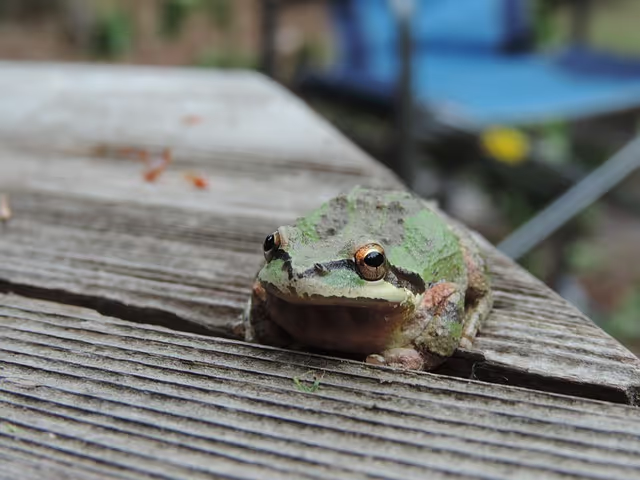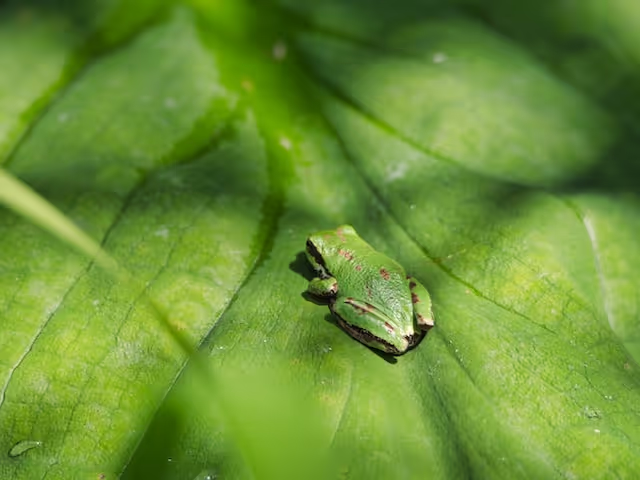The Pacific Tree Frog: Part 1


Introduction
Welcome to the first installment of a two-part series of posts looking at the Pacific Tree Frog! In this series, we will be exploring everything you need to know about this fun species of frog, from their physical characteristics and color patterns to their feeding habits and vocalization. We will also be diving into a couple of debates surrounding the species, including how long their lifespan is, and whether there is just one Pacific Tree Frog species or three. Let’s begin with their key physical characteristics.
Key Physical Characteristics
The Pacific Tree Frog’s skin is always moist. The skin stays moist because glands in the frog’s skin secrete a waxy coating (4). The skin is covered with what small bumps.
Both male and female Pacific Tree Frogs have relatively flattened bodies, long and thin legs, large heads, large eyes, relatively smooth skin and pointed snouts (2). The tips of the frog’s toes have “toe-pads” (5). These are sticky circular discs that stick well to smooth surfaces. Their toes feature only limited webbing between them (5).
Size
Pacific Tree Frogs are small frogs. Tadpoles grow to approximately two inches in length before undergoing metamorphosis, after which they emerge being just 0.5 to 0.7 inches long (3). As they age into adulthood, the length that they will grow to can vary considerably. Adult Pacific Tree Frogs are believed to measure anywhere from 0.75 inches long to 1.9 inches long (2.5 to 4.8 centimeters) (2). Females tend to be larger than males (5).
Adult Color Patterns
As is the case with many frog species, adult Pacific Tree Frogs can take on an array of different color patterns. Their legs and dorsal (topside of the body) offer the most variety of appearances.
The variety in colorization continues across the rest of the adult Pacific Tree Frog’s body. The ventral (underside of the body) is mostly white (3). Their legs, as well as the sides of their stomachs, may feature yellow to yellowish-orange coloration (3). Additionally, adult male Pacific Tree Frogs have a darkly pigmented patch on their throats (3). This patch features wrinkly skin and a translucent yellow wash (3).
Most adult Pacific Tree Frogs have a distinctive stripe that runs from their nostrils to their shoulders, crossing through their eyes. The stripe is known as the “eye stripe”, and can range in color from black to dark brown (5). Additionally, it is common for Pacific Tree Frogs to have two or three stripes running down theirs back, as well as a “Y” shaped marking to exist on their head between their eyes (3). These markings may be subtle or discontinuous, meaning that they can appear more like blotches or spots (3).
While the Pacific Tree Frog’s official body doesn’t change, their actual body color can change depending on the air temperature and humidity (5). When temperatures are colder, the frog will sport green coloring and when temperatures are warmer, the frog will feature brown coloring (5).
Juvenile Color Patterns
Young Pacific Tree Frog tadpoles have eyes located on their margins of their heads. The eyes can stick out from the head’s overall outline (3). Tadpoles also have tail fins that feature a high arch (3). The tail fin is located halfway along their back, and features a rounded tip (3). Tadpoles normally sport brown or olive coloring with black speckling spots (3). Their ventral sides are white with a metallic iridescence (3).
Feeding Behavior and Diet
When Pacific Tree Frogs are not breeding, they are nocturnal. This means that they feed at night and hide during the day (2). When they are breeding, however, they will feed around the clock (2). Adult Pacific Tree Frogs are mainly ground-feeders, consuming a diet of invertebrates (2). This can include flies, beetles, spiders, and ants (4). Northern Pacific Tree Frogs have good eyesight, which helps them track down pray (2). They then catch their prey by shooting out their long, sticky tongue. Tadpoles are suspension feeders (2). They consume a diet of algae (2), bacteria, diatoms, and detritus (1).

Photo by Kieran Wood on Unsplash
Other Behaviors
During periods of wet weather, Pacific Tree Frogs move around in areas in low vegetation (2). In locations with more moderate temperatures and lower elevations, such as here in Ocean Shores, frogs may be active year-round (2). In locations that feature more varied temperatures and higher elevations, frogs will hibernate in moist shelters, such as areas with dense vegetation, crevices, mammal burrows, and debris piles, to avoid temperatures that are too cold or too warm (2).
When Pacific Tree Frogs are disturbed, they will either jump into the water and find a hiding spot amongst vegetation, or hop a large distance away from the source of the disturbance (2).
Breeding and Eggs
The timing of the Pacific Tree Frog’s annual breeding season is location dependent, and can take place anytime between November and July (6). When it begins, adult Pacific Tree Frogs will migrate to areas where water is present (2). Desired breeding habitats include everything from slow-moving streams and vernal ponds to swamps, lakes, and marshes (2). Once the adults arrive at the locations in which they intend to breed at, territorial males will advertise their suitability to females. They do this by calling at all hours of the day and night (2). They will then defend their territory physically, by butting and wrestling with other males (2).
Once bonded pairs are formed, female Pacific Tree Frogs will lay eggs into the water while the male fertilizes them externally (2). They will lay anywhere from 400 to 750 eggs in clusters of 10 to 80 eggs each (2). The clusters measure one to two inches across, and are surrounded by a unique “jelly” that swells up when it makes contact with water (4). Females then attach the clusters to sticks or other “emergent” aquatic vegetation just below the surface (4). The clusters often become disguised with sediment and algae (4). Once the clusters have been placed, the adults then return to their non-breeding habitats, leaving the eggs on their own (2).
From Tadpole to Froglet
Despite becoming disguised by sediment and algae, it isn’t uncommon for some of the Pacific Tree Frog eggs to be eaten before they hatch (4). Fungus, frost, fish, and caddisfly larvae are the most common culprits (4). The eggs typically hatch two to three weeks after they are laid (1). Once the eggs hatch, the hatchlings quickly turn into tadpoles and enter the larval stage, which extends for two to three months (1). However, many tadpoles don’t last that long, as they can be eaten by a wide array of predators, including dragonfly larvae, garter snakes, and some bird species (4). The tadpoles that do manage to survive the larval stage then begin transforming into froglets through process known as metamorphosis. This process takes approximately three months to complete (6).
Living on Land
Once they become froglets, Pacific Tree Frogs are considered to be terrestrial animals (3). However, they must live near bodies of water or in moist microhabitats to ensure their survival (3). There are many different environments that can satisfy their needs, including forests, prairies, alpine areas, shrublands, and grasslands (3).
This “Tree” Frog Doesn’t Climb Trees
While the Pacific Tree Frog has the word “tree” in its name, you are unlikely to actually find members of this species climbing any trees (2). The reason for this is that they prefer to live on the ground or in shrubs (2). Despite not climbing trees, Pacific Tree Frogs will climb other types of tall vegetation (2).
Next Time
In our second post about the Pacific Tree Frog, we’ll take a look at their vocalization, address the debate surrounding how long their lifespan is, and dive into the question of whether there is one Pacific Tree Frog species or three! We hope to see you then!
References
© Ian Caldwell, January 2024
Touch whale bones, examine shipwreck artifacts and connect with the coast's living history.

Support our mission, get involved in educational programs, or contribute through donations and volunteering.